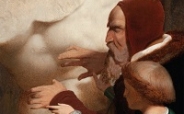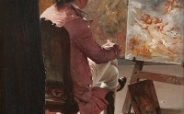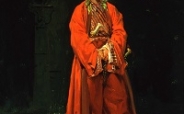DAHESH MUSEUM OF ART ANNOUNCES FIVE NEW ACQUISITIONS
— World-Renowned Collection of 19th-Century Art Continues to Grow
Prior to Moving to New Museum Space —
New York, April 1, 2015 – The Dahesh Museum of Art today announced the acquisition of five new works that will significantly enhance its world-renowned collection of 19th-century art. The acquisitions, spanning 1851 to 1874, include three bronze statues, one oil on canvas painting, and one pencil and watercolor study heightened with gouache on card. The works are by artists Marius Jean Antonin Mercié (1845–1916), Aimé-Jules Dalou (1838–1902), Rosa Bonheur (1822–1899), and Sir Lawrence Alma-Tadema (1836–1912).
Rosa Bonheur was the focus of an international retrospective created by the Dahesh Museum of Art in 1997; this is the seventh work by Bonheur to enter the Dahesh Museum collection. The watercolor study by Alma-Tadema is the preparatory work for a finished painting that is also within the Museum’s holdings. Alma-Tadema is among the most collectible Victorian artists (his painting The Finding of Moses sold at Sotheby’s in 2010 for $36 million). The three sculptures, by artists Mercié and Dalou, were a gift from Tracy and Laurel Pulvers.
“We are grateful to add these important works to our collection, and to eventually make them available to the public once we open at our new space at 178 East 64th Street,” said J. David Farmer, Director of Exhibitions for the Dahesh Museum of Art. “We have been actively acquiring new work for the past four years, and these works expand our growing insight into the 19th century and elaborate upon works we already possess.”
New Acquisitions
Marius Jean Antonin Mercié (French, 1845–1916)
David, ca. 1872
Bronze, brown patina, 25 1/2 x 12 3/4 x 17 7/8 in.
Signed on base, top right: A. MERCIÉ. Stamped on base at side back center: REDUCTION MECANIQUE A. COLLAS BREVETÉ.
Gift of Tracy and Laurel Pulvers
2014.4
Mercié, one of the most successful sculptors of late 19th- and early 20th-century France, began as a pupil of François Jouffroy and Alexandre Falguière at the École des Beaux-Arts in Paris. He won the Prix de Rome in 1868 and found immediate success with the first plaster model of David that he executed while in Rome. This sculpture offered a glimmer of hope for France after its crushing defeat by Prussia in 1871. David, armed with a slingshot, brought down the giant Goliath, proving that France too could triumph over its enemy. The State awarded Mercié the Legion of Honor and in 1872 commissioned a bronze version of David (Musée d’Orsay). The Barbedienne foundry cast a miniature version in six different sizes.
Marius Jean Antonin Mercié (French, 1845–1916)
Gloria Victis (Glory of the Vanquished), modeled ca. 1874, cast after 1879
Bronze, dark brown patina with gilt highlights, 36 5/8 x 21 x 16 in.
Signed on base right: A. MERCIE. Inscribed on base at front edge: GLORIA VICTIS. Foundry mark on back base: F. BARBEDIENNE, Fondeur Paris. Stamped on back base: REDUCTION MECANIQUE A. COLLAS BREVETE.
Gift of Tracy and Laurel Pulvers
2014.3
Mercié executed the plaster model for this group while studying in Italy as a Prix de Rome boursier and exhibited it at the 1874 Salon. The winged female figure carrying a wounded soldier holding a broken sword expresses the loss and sacrifice of the French at the hands of the Prussians in the 1870-71 war. The sculpture won critical and popular acclaim. In his review of the Salon that year, the critic Jules-Antoine Castagnary observed: “while monarchists quarrel over the debris of our battered fortunes…there exists a young sculptor who has undertaken to speak directly to our nation and to console our people who have suffered so much.” Mercié received a medal of honor, the city of Paris purchased the sculpture for 12,000 francs, and the model was cast in bronze by Thiébaut et fils (Musée du Petit Palais, Paris). Replicas of it adorned monuments dedicated to those who served in the Franco-Prussian War in many towns and cities throughout France, and the Barbedienne Foundry provided bronze reproductions in different sizes.
Aimé-Jules Dalou (French, 1838–1902)
The Woman of Boulogne
Bronze, green patina, 24 3/4 x 7 7/8 x 6 5/8 in.
Signed on base back top: Dalou. Foundry mark on base back bottom edge center: SUSSE Fres PARIS …rcue. Foundry mark on base bottom right: SUSSE FRÈRES EDITEURS PARIS. Inscribed on base bottom right: Susse Fes EJes Paris
Inscribed on base, bottom right: Susse Fes EJes Paris
Gift of Tracy and Laurel Pulvers
2014.5
Best known for his public monuments in Paris, in 1870 Dalou began to create statuettes of women. During his exile in London from 1871 to 1879 following the fall of the Paris Commune, he executed a series of women from Boulogne—a theme made popular by the paintings of Alphonse Legros, who also lived in England at that time. The original composition, entitled Palm Sunday at Boulogne, was exhibited at the Royal Academy in 1872 and purchased by George Howard, later Earl of Carlisle. A girl returning from church clasps a prayer book and a branch of leaves, referencing the Palm Sunday mass. In London, Dalou frequently exhibited at the Royal Academy and taught at the National Art Training School in South Kensington (later the Royal College of Art), where he had a profound influence on the development of British sculpture
Rosa Bonheur (French, 1822–1899)
Going To Market, 1851
Oil on canvas, 19 x 27 1/4 in.
Signed and dated lower right: Rosa Bonheur 1851
2014.6
When 29-year-old Bonheur painted Going to Market, her reputation as an animal painter was already firmly established. The composition, peasants with their ox-drawn carts, demonstrates Bonheur’s command of animal anatomy, which she had studied at horse fairs, cattle markets, and in the family menagerie. While Bonheur won the highest artistic and governmental honors in France, her works were also greatly admired in Great Britain and the United States.
Sir Lawrence Alma-Tadema (Dutch/British, 1836–1912)
Study for Joseph, Overseer of Pharaoh’s Granaries, ca. 1874
Pencil and watercolor heightened with gouache on card, 16 3/4 x 22 in.
2014.7
This sheet by Alma-Tadema is related to the splendid painting in the Dahesh Museum collection, Joseph Overseer of Pharaoh’s Granaries (acquired in 2002), first exhibited in 1874 at the Royal Academy. The subject derives from the Book of Genesis, with Joseph seated on a throne in his role as the Pharaoh’s overseer of the royal granaries, accompanied by a scribe reading him the account of sales. The finished painting follows the general composition and colors of the sketch, with the addition of details of the ancient Egyptian decorations and accoutrements. This study was previously in the collection of Andy Warhol.
About the Dahesh Museum of Art
The Dahesh Museum of Art is the only institution in the United States devoted to collecting, exhibiting, and interpreting works by Europe and America’s academically trained artists of the 19th and early 20th centuries. The Dahesh serves a diverse audience by placing these artists in the broader context of 19th-century visual culture, and by offering a fresh appraisal of the role academies played in reinvigorating the classical ideals of beauty, humanism, and skill. Visit us at: http://www.daheshmuseum.org.








